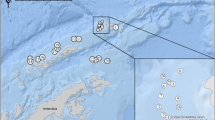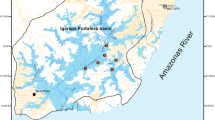Abstract
Parasites are affected by the environment where their hosts live, having a specific distribution among their hosts and occupying a well-defined microhabitat. The present work aims to describe the metazoan ectoparasite fauna of Scomber scombrus, namely its distribution at the macro- and microhabitat levels. For that, fish from two different Portuguese regions, Matosinhos (n = 40) and Figueira da Foz (n = 39), were examined for macroectoparasites. S. scombrus of Matosinhos presented four different parasite species, whilst fish from Figueira da Foz presented five species. All parasites belonged to Monogenea, Copepoda, or Isopoda. The main differences between infection levels of fish from the two localities were found in Grubea cochlear (higher infection levels in Matosinhos) and Caligus pelamydis (where the highest values were found in Figueira da Foz). Regarding the microhabitat of the reported ectoparasites, it could be seen that every species has a very specific distribution within the host: G. cochlear and Kuhnia scombri have a preference for the inner medial areas of gills, Kuhnia sprostonae for the pseudobranchs, and C. pelamydis for the internal wall of opercula. The numerical and functional responses to interspecific competition were absent. These results support the idea that the parasite driving forces of community structure are the reinforcement of reproductive barriers and the enhancement of chances to mate.





Similar content being viewed by others
References
Baylis HA (1938) On two species of the trematode genus Didymozoon from the mackerel. J Mar Biol Assoc UK 22(2):485–492. doi:10.1017/S0025315400012388
Brusca RC, Iverson EW (1985) A guide to the marine Isopod Crustacea of Pacific Costa Rica. Rev Biol Trop 33:1–75
Bush AO, Aho JM, Kennedy CR (1990) Ecological versus phylogenetic determinants of helminth parasite community richness. Evol Ecol 4(1):1–20. doi:10.1007/bf02270711
Bush AO, Lafferty KD, Lotz JM, Shostak AW (1997) Parasitology meets ecology on its own terms: Margolis et al. revisited. J Parasitol 83(4):575–583. doi:10.2307/3284227
Castro R (2012) Ectoparasites of Atlantic mackerels (Scomber colias and S. scombrus): biological tags and macro and microhabitats dynamics. Dissertation, University of Porto
Cavaleiro FI, Santos MJ (2011) Site selection of Acanthochondria cornuta (Copepoda: Chondracanthidae) in Platichthys flesus (Teleostei: Pleuronectidae). Parasitol 138(8):1061–1067. doi:10.1017/s0031182011000606
Collette BB (1986) Scombridae. In: Whitehead PJP, Bauchot M-L, Hureau J-C, Nielsen J, Tortonese E (eds) Fishes of the north-eastern Atlantic and the Mediterranean. Vol 2. UNESCO, Paris, pp 981–997
Costello MJ (2006) Ecology of sea lice parasitic on farmed and wild fish. Trends Parasitol 22(10):475–483. doi:10.1016/j.pt.2006.08.006
Cressey RF, Cressey HB (1980) Parasitic copepods of mackerel- and tuna-like fishes (Scombridae) of the world. Smithsonian Institution, Washington, DC
Dawson LHJ, Renaud F, Guégan JF, de Meeûs T (2000) Experimental evidence of asymmetrical competition between two species of parasitic copepods. Proc R Soc Lond B 267:1973–1978. doi:10.1098/rspb.2000.1238
Dezfuli BS, Giari L, Poulin R (2001) Costs of intraspecific and interspecific host sharing in acanthocephalan cystacanths. Parasitol 122:483–489. doi:10.1017/S003118200100745
European Environmental Agency (2011) Biogeographical regions in Europe: the North-East Atlantic Ocean—huge, deep and heavily exploited. http://www.eea.europa.eu/ publications/report_2002_0524_154909/page121.html/#1. Accessed 4 April 2013
Euzet L, Combes C (1998) The selection of habitats among the Monogenea. Int J Parasitol 28(10):1645–1652. doi:10.1016/s0020-7519(98)00062-9
Geets A, Coene H, Ollevier F (1997) Ectoparasites of the whitespotted rabbitfish, Siganus sutor (Valenciennes, 1835) off the Kenyan coast: distribution within the host population and site selection on the gills. Parasitol 115:69–79. doi:10.1017/s0031182097001054
Holmes JC (1973) Site selection by parasitic helminths: interspecific interactions, site segregation, and their importance to the development of helminth communities. Can J Zool 51(3):333–347. doi:10.1139/z73-047
Instituto Hidrográfico (2013) Bóias Ondógrafo. http://www.hidrografico.pt/boias-ondografo.php. Accessed 20 March 2013
Kabata Z (1979) Parasitic Copepoda of British fish. The Ray Society, London
Kabata Z (1992) Copepods parasitic on fishes, vol 47. Universal Book Services/Dr.W, Backhuys, Oegstgeest
Koskivaara M, Valtonen ET, Prost M (1991) Dactylogyrids on the gills of roach in central Finland: features of infection and species composition. Int J Parasitol 21(5):565–572. doi:10.1016/0020-7519(91)90061-b
Koskivaara M, Valtonen ET, Vuori KM (1992) Microhabitat distribution and coexistence of Dactylogyrus species (Monogenea) on the gills of roach. Parasitol 104:273–281
Llewellyn J (1956) The host-specificity, micro-ecology, adhesive attitudes, and comparative morphology of some trematode gill parasites. J Mar Biol Assoc U K 35(1):113–127
Lo CM, Morand S (2001) Gill parasites of Cephalopholis argus (Teleostei: Serranidae) from Moorea (French Polynesia): site selection and coexistence. Folia Parasitol 48(1):30–36
Martins MM (2007) Growth variability in Atlantic mackerel (Scomber scombrus) and Spanish mackerel (Scomber japonicus) off Portugal. ICES J Mar Sci 64(9):1785–1790. doi:10.1093/icesjms/fsm163
Oktener A, Trilles J-P (2009) Four parasitic copepods on marine fish (Teleostei and Chondrichthyes) from Turkey. Acta Adriat 50(2):121–128
Poulin R (2001) Interactions between species and the structure of helminth communities. Parasitol 122:S3–S11
Pozdnyakov SE, Gibson DI (2001) Family Didymozoidea Monticelli, 1888. In: Bray RA, Gibson DI, Jones A (eds) Keys to the Trematoda. CABI and Natural History Museum, London, p 631–734
Ramasamy P, Ramalingam K, Hanna REB, Halton DW (1985) Microhabitats of gill parasites (Monogenea and Copepoda) of teleosts (Scomberoides spp.). Int J Parasitol 15(4):385–397. doi:10.1016/0020-7519(85)90023-2
Rego AA, Carvalho-Varela M, Mendonça MM, Afonso-Roque MM (1985) Helmintofauna da sarda (Scomber scombrus L.) peixe da Costa Continental Portuguesa. Mem Inst Oswaldo Cruz 80:97–100
Rohde K (1977) A non-competitive mechanism responsible for restricting niches. Zool Anz 199:164–172
Rohde K (1979) A critical evaluation of intrinsic and extrinsic factors responsible for niche restriction in parasites. Am Nat 114:648–671
Rohde K (1980) Comparative studies on microhabitat utilization by ectoparasites of some marine fishes from the North Sea and Papua New Guinea. Zoologischer Anzeiger 204:27–63
Rohde K (1984) Ecology of marine parasites. Helgol Mar Res 37(1):5–33. doi:10.1007/bf01989293
Rohde K (1986) Grubea australis n. sp. (Monogenea, Polyopisthocotylea) from Scomber australasicus in southeastern Australia, and Grubea cochlear Diesing, 1858 from S. scombrus and S. japonicus in the Mediterranean and western Atlantic. Syst Parasitol 9(1):29–38
Rohde K (1989) Kuhnia sprostonae Price, 1961 and Kuhnia scombercolias Nasir and Fuentes Zambrano, 1983 (Monogenea, Mazocraeidae) and their microhabitats on the gills of Scomber australasicus (Teleostei, Scombridae), and the geographical distribution of 7 species of gill Monogenea of Scomber spp. Systematic Parasitol 14(2):93–100. doi:10.1007/bf00016903
Rohde K (1993) Ecology of marine parasites, 2nd edn. CABI, Oxon
Rohde K (1994) Niche restriction in parasites: proximate and ultimate causes. Parasitol 109:69–84
Rohde K (2005) Marine parasitology. CSIRO Melbourne and CABI, Wallingford
Rohde K, Hobbs R (1986) Species segregation: competition or reinforcement of reproductive barriers? In: Cremim M, Dobson C, Moorhouse DE (eds) Parasite lives papers on parasites, their hosts and their association to honour JFA Sprent. University of Queensland Press, St. Lucia, pp 189–199
Rohde K, Watson N (1985a) Morphology and geographical variation of Pseudokuhnia minor n. g., n. comb. (Monogenea: Polyopisthocotylea). Int J Parasitol 15(5):557–567. doi:10.1016/0020-7519(85)90053-0
Rohde K, Watson N (1985b) Morphology, microhabitats and geographical variation of Kuhnia spp. (Monogenea: Polyopisthocotylea). Int J Parasitol 15(5):569–586. doi:10.1016/0020-7519(85)90054-2
Romuk-Wodoracki D (1988) Parasitic fauna of Atlantic mackerel (Scomber scombrus L.) from the fishing grounds of Cape Hatteras. Acta Ichthyol Piscat 18(1):49–60
Scoles DR, Collette BB, Graves JE (1998) Global phylogeography of mackerels of the genus Scomber. Fish Bull 96(4):823–842
Scott-Holland TB, Bennett SM, Bennett MB (2006) Distribution of an asymmetrical copepod, Hatschekia plectropomi, on the gills of Plectropomus leopardus. J Fish Biol 68(1):222–235. doi:10.1111/j.1095-8649.2005.00895.x
Šimková A, Rohde K (2013) Community stability and instability in ectoparasites of marine and freshwater fish. In: Rohde K (ed) The balance of nature and human impact. Cambridge University Press, Cambridge, pp 75–87
Somdal O, Schram TA (1992) Ectoparasites on northeast Atlantic mackerel (Scomber scombrus L) from western and north sea stocks. Sarsia 77(1):19–31
Tinsley RC, Jackson JA (2002) Host factors limiting monogenean infections: a case study. Int J Parasitol 32(3):353–365. doi:10.1016/s0020-7519(01)00336-8
Whittington ID, Chisholm LA, Rohde K (1999) The larvae of Monogenea (Platyhelminthes). In: Baker JR, Muller R, Rollinson D (eds) Advances in parasitology. Volume 44. Academic, New York, p 139–232
Acknowledgments
This work was supported by the Fundação para a Ciência e a Tecnologia with the projects CIIMAR/C2008/BII-11/2010, FCOMP-01-0124-307 FEDER-020726 (Refª FCT PTDC/MAR/116838/2010), and PEst-C/MAR/LA0015/2013.
Author information
Authors and Affiliations
Corresponding author
Rights and permissions
About this article
Cite this article
Castro, R., Santos, M.J. Metazoan ectoparasites of Atlantic mackerel, Scomber scombrus (Teleostei: Scombridae): macro- and microhabitat distribution. Parasitol Res 112, 3579–3586 (2013). https://doi.org/10.1007/s00436-013-3543-8
Received:
Accepted:
Published:
Issue Date:
DOI: https://doi.org/10.1007/s00436-013-3543-8




